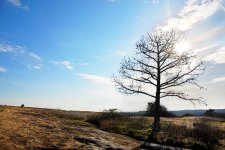wordlesstu
Senior Member
Hi,
I brought my D200 to shot at Arabia Mountain in Georgia yesterday. I was trying to experiment different combination of Aperture/shutter speed to see what is the best. I come across couple questions, and I am looking forward to hearing all your comments. Just a short note, does anyone know how to find out what Aperture/shutter speed I used once I uploaded the image to a computer or the album? Do I need to download a particular software?
Group 1 photo:
1. For this shot, I want to was trying to show the tree and the detail of the land, and allow the sunlight come in through the upper right part. However, how can I let the sun stay in shape in the photo instead of radiating out the lights? Can anyone also comments on which photo comes out the best result?
1. Group1-01

Group 1- 02

Group 1-03

Group 1-04

Group 02 - For this photo, I want to achieve: 1. The reflection of sun on the lake. 2. The detail of the stone. When I lower the exposure down, the stones are too dark. When I increase the exposure, the reflection of the light is not as detail. Can anyone advise?
Group2-01

Group 2-02

Group 2-03

Group 2-04

Group 02-05

More in the next post.Thank you, :cheerful: everyone!
I brought my D200 to shot at Arabia Mountain in Georgia yesterday. I was trying to experiment different combination of Aperture/shutter speed to see what is the best. I come across couple questions, and I am looking forward to hearing all your comments. Just a short note, does anyone know how to find out what Aperture/shutter speed I used once I uploaded the image to a computer or the album? Do I need to download a particular software?
Group 1 photo:
1. For this shot, I want to was trying to show the tree and the detail of the land, and allow the sunlight come in through the upper right part. However, how can I let the sun stay in shape in the photo instead of radiating out the lights? Can anyone also comments on which photo comes out the best result?
1. Group1-01

Group 1- 02

Group 1-03

Group 1-04

Group 02 - For this photo, I want to achieve: 1. The reflection of sun on the lake. 2. The detail of the stone. When I lower the exposure down, the stones are too dark. When I increase the exposure, the reflection of the light is not as detail. Can anyone advise?
Group2-01

Group 2-02

Group 2-03

Group 2-04

Group 02-05

More in the next post.Thank you, :cheerful: everyone!
















